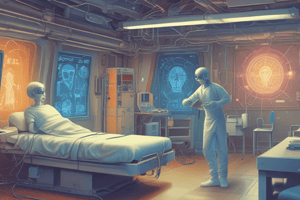Podcast
Questions and Answers
What is the overall aim of the course Dark Room-1 A?
What is the overall aim of the course Dark Room-1 A?
- To provide basic knowledge about the dark room processing steps
- To promote advanced knowledge about new x-ray examination techniques (correct)
- To teach students about the history of darkrooms in photography
- To focus on developing photography skills
According to the course description, what will students be able to do by the end of this course?
According to the course description, what will students be able to do by the end of this course?
- Understand the history of darkrooms in photography
- Identify the different types of x-ray films and cassettes (correct)
- Develop photography skills for darkroom processing
- Learn how to take x-ray images using manual processing only
What is the main focus of the course Dark Room-1 A?
What is the main focus of the course Dark Room-1 A?
- Learning about the history of darkrooms in photography
- Developing photography skills for various lighting conditions
- Teaching different methods of x-ray film processing (correct)
- Understanding the difference between CR, DR, and PACS systems
What is one of the objectives of the course Dark Room-1 A?
What is one of the objectives of the course Dark Room-1 A?
What is mentioned as a key capability that students will have after completing the course?
What is mentioned as a key capability that students will have after completing the course?
What has been used since the inception of photography in the early 19th century?
What has been used since the inception of photography in the early 19th century?
What is the primary purpose of a darkroom in photography?
What is the primary purpose of a darkroom in photography?
What is the ideal temperature for a darkroom according to the text?
What is the ideal temperature for a darkroom according to the text?
What material should the walls of a darkroom be constructed from?
What material should the walls of a darkroom be constructed from?
What is the importance of having sufficient running water in a darkroom?
What is the importance of having sufficient running water in a darkroom?
What should be provided near the x-ray examination area according to the text?
What should be provided near the x-ray examination area according to the text?
What shape should the darkroom be according to the text?
What shape should the darkroom be according to the text?
What is the purpose of the lead thickness mentioned in the text?
What is the purpose of the lead thickness mentioned in the text?
What should be painted on the walls and roof of the darkroom according to the text?
What should be painted on the walls and roof of the darkroom according to the text?
What happens if the temperature in the darkroom is higher than 28 °C?
What happens if the temperature in the darkroom is higher than 28 °C?
What are some essential features of a well-constructed dark room?
What are some essential features of a well-constructed dark room?
Flashcards are hidden until you start studying
Study Notes
Course Overview
- Aim of Dark Room-1 A is to equip students with practical skills in photographic processes and darkroom techniques.
- By course completion, students will understand darkroom procedures and produce quality photographic prints.
Course Focus
- Main focus on hands-on experience with traditional photographic development processes.
- Emphasis on understanding chemistry involved in developing film and printing photographs.
Course Objectives
- One objective is to foster an appreciation for the historical aspects of photography and its evolution.
- Students will also gain problem-solving skills applicable to photographic challenges.
Key Capabilities
- After completing the course, students will be proficient in the operation of darkroom equipment and processes.
- Enhanced ability to critique photographic work effectively.
Historical Context
- Film has been used since photography's inception in the early 19th century as a medium for capturing images.
Darkroom Functions and Requirements
- Primary purpose of a darkroom is to provide a light-tight environment for developing photographs.
- Ideal darkroom temperature is maintained below 28 °C to ensure proper chemical reactions during development.
- Darkroom walls should be constructed from non-reflective materials to minimize light contamination.
Importance of Water Supply
- Sufficient running water is crucial for rinsing and washing developed film and prints, ensuring image quality.
Spatial and Safety Considerations
- Facilities near x-ray examination areas should be equipped with appropriate shielding for safety.
- The recommended shape for a darkroom is typically rectangular to optimize workflow and space usage.
Lead Thickness
- Lead thickness in darkrooms safeguards against radiation exposure, particularly in medical and dental imaging settings.
Surface Treatments
- Walls and ceiling of the darkroom should be painted in dark, non-reflective colors to absorb excess light.
Temperature Regulation
- Higher temperatures than 28 °C can adversely affect chemical development, risking poor image quality.
Essential Features
- Essential darkroom features include proper ventilation, adequate shelving for materials, and secure chemical storage.
- Accessibility to light-proof storage for photographic paper and undeveloped film is important for maintaining integrity.
Studying That Suits You
Use AI to generate personalized quizzes and flashcards to suit your learning preferences.




